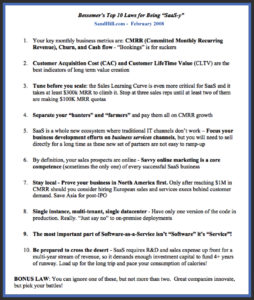 It only takes a keyboard to write a market forecast – but it takes guts to look back on your predictions and take stock of their accuracy.
It only takes a keyboard to write a market forecast – but it takes guts to look back on your predictions and take stock of their accuracy.
As author of landmark SandHill.com articles – 2008’s “Top 10 Laws of Being SaaS-y” and 2009’s “Top 10 Laws of Cloud Computing” – Byron Deeter of Bessemer Venture Partners threw a series of stakes in the ground by which the authenticity, viability and success of subsequent SaaS ventures were measured. Over the past decade, Deeter and Bessemer invested in over 110 startups, nurtured the ecosystem, and educated Wall Street.
The 2017 Forbes Midas List member and father of SaaS and Cloud metrics joined me for a look back at what laws worked, what laws need tweaking for today’s market, and what “white spaces” remain for today’s cloud entrepreneurs.
M.R. Rangaswami: Which of your 2008’s “Top 10 Laws of Being SaaS-y” still remain true nine years after they were written?
1. Your key monthly business metrics are: CMRR (Committed Monthly Recurring Revenue), Churn, and Cash flow – “Bookings” is for suckers
2. Customer Acquisition Cost (CAC) and Customer LifeTime Value (CLTV) are the best indicators of long-term value creation
Byron Deeter: Laws 1 and 2 remain true. I continue to believe CMRR, CAC and CLTV are the supreme metrics for SaaS success. That said, a more nuanced view has emerged as Wall Street has become more sophisticated in evaluating SaaS companies. We now encourage looking at the interrelationship between CMRR growth to free cash flow, and revenue growth to earnings. We feel these are a more accurate predictor of success for SaaS companies.
We created the BVP Efficiency Rule to quantify this, which is the rate of CMRR growth plus free cash flow. If a company is growing 70% but burning -40% free cash flow, its efficiency score is 30 – lower than the top peer benchamarks. BVP finds top performing IPOs at 50+ and we often see growth stage companies at 70+.
We also look at the relationship between CAC and CLTV. We want to see a ratio of at least 1:3 because we find that the spend on acquiring a customer should pay back 3x – and in some cases 4x-5x – in lifetime value.
5. SaaS is a whole new ecosystem where traditional IT channels don’t work – Focus your business development efforts on business services channels, but you will need to sell directly for a long time as these new set of partners are not easy to ramp-up
Law 5 definitely still applies. For the most part, channels in the cloud have continued to be tough to scale, primarily because the cloud is a low friction model that doesn’t require hardware or services along with the software solution. This is great for customers, but traditional channel partners don’t get the pull through of their solutions, meaning much less incentive to sell your solution.
Most cloud companies are excited to control their own destiny and not have to worry about support from downstream partners, which is still, almost always, the right answer.
6. By definition, your sales prospects are online – Savvy online marketing is a core competence (sometimes the only one) of every successful SaaS business
Law 6 is truer than ever. Today’s information-empowered buyers find out all about a cloud product long before they contact the vendor. This can be bad if you get ruled out before a potential customer ever talks to a human at your company. It is important for marketing materials to be more substantive, thoughtful and detailed than ever before. This is not to say freemium is the only way to go. While lower friction purchases may lend themselves to free trials, it doesn’t make sense for complex deployments that need implementation and configuration. It is worth noting that the leading cloud players like Salesforce and Workday have never offered a free trial version.
7. Stay local – Prove your business in North America first. Only after reaching $1M in CMRR should you consider hiring European sales and services execs behind customer demand. Save Asia for post-IPO
For companies that sell directly to the enterprise, Law 7 still applies. It makes sense to reach meaningful scale before launching overseas options.
However, I should make two exciting notes here that challenge this law. One, many companies are successfully selling internationally before they open an overseas office. And, two, many businesses are launching internationally in the cloud from Europe and Asia and then coming to the U.S.
3. Tune before you scale: the Sales Learning Curve is even more critical for SaaS and it takes at least $300k MRR to climb it. Stop at three sales reps until at least two of them are making $100K MRR quotas
9. The most important part of Software-as-a-Service isn’t “Software” it’s “Service”!
10. Be prepared to cross the desert – SaaS requires R&D and sales expense up front for a multi-year stream of revenue, so it demands enough investment capital to fund 4+ years of runway. Load up for the long trip and pace your consumption of calories!
Yes, yes and yes. These three laws still apply, and startups need to be thoughtful and efficient as they scale.
M.R.: Which of your “laws” do you feel don’t quite apply to today’s cloud market?
4. Separate your “hunters” and “farmers” – and pay them all on CMRR growth
Byron: Over the years, we realized Law 4 involves a lot more “art” and a lot less “science.” We discovered the sales model to be very company specific. This advice was more tied to the traditional enterprise software sales process, which had a strategic cycle and distinct buying event. In that scenario, we feel it makes sense to have a “hunter” hand off the client to a “farmer” for better management of the relationship and renewals over time.
Most modern cloud businesses have a much more evolutionary sales process that starts small and grows over time. Many of these companies have chosen not to separate “hunters” from “farmers” in order to maintain the original client-salesperson relationship and develop it over time.
8. Single instance, multi-tenant, single datacenter – Have only one version of the code in production. Really. “Just say no” to on-premise deployments
Law 8 is still applicable but there are two even more important trends for cloud developers to consider.
First, it is important to leverage the explosion of the API economy and the business-to-developer (B2D) ecosystem. Individual developers are deciding which tool sets to use which means they are finding the best products, rather than being stuck with a decision by a CIO, VP of Engineering or other higher up. These developers are picking the best products, integrating them and pulling them through their solution. This speeds innovation and helps best-of-breed products rise to the top.
Second, all applications need to be “mobile awesome.” They don’t need to be mobile first or native but they must consider mobile a critical interface as they build their apps.
M.R. Does BVP see any remaining “white spaces” in the cloud space?
Byron: We continually conduct a “road mapping” process to identify upcoming market segments for development. We now have ten active road maps in the cloud with several sub-segments currently of high interest. Some of these we’ve shared publicly, including the “API Revolution” and the expanding API layer we discussed earlier.
We are also watching “screenless software,” a fairly recent trend in which the application interface disappears and the backend is powered by the cloud. Alexa, Siri, and Google Home are great examples of this, leveraging messaging and voice commands. Finally, we are looking at “human assisted AI” products that leverage technology to make humans better at what they do.
We also continue to see the emergence of vertical SaaS, and best-of-breed vendors challenging the larger suite platform providers. It used to be that software suite vendors succeeded by locking out other vendors’ products by saying they didn’t work with the suite. Now best-of-breed vendors are dominating categories in the new world, using the Internet as their middleware. They speak together smoothly across different layers of the stack and allow “faster, cheaper, better” products to be built with state of the art components – most with dozens of integrated services that are live and operational at all times.
At Bessmer, we’re proud of the role we’ve played in the development of the ecosystem as the largest investor in cloud computing. We’ve made more than 110 investments, held conferences for CEOs, published annual “State of the Cloud” reports, created the BVP Cloud Index for public companies and participated in 13 cloud IPOs to date. It has been exciting to be an early leader in this space and we hope to continue to play that role going forward.
M.R. Rangaswami is the co-founder of Sand Hill Group and publisher of SandHill.com.

